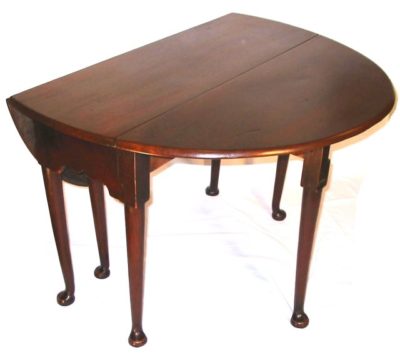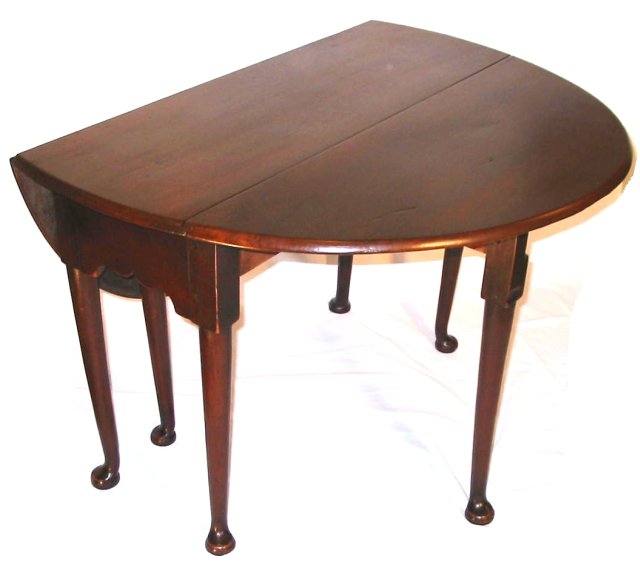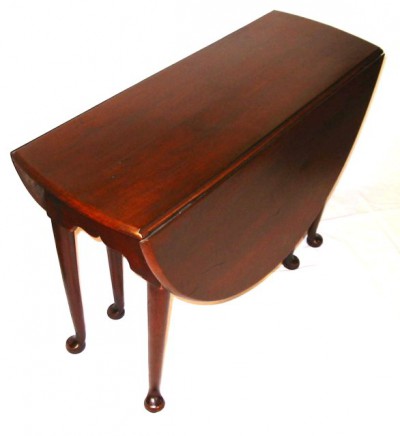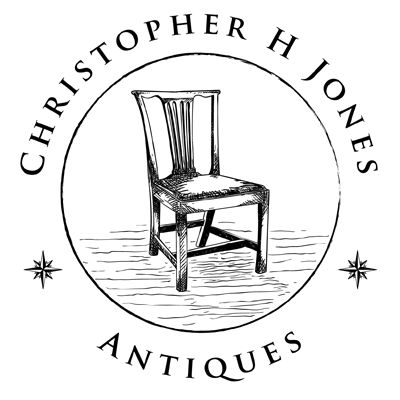 Virginia
Virginia
Circa 1750 – 1770
HOA 28″ DOA 41″ WOA 16 1/2″ (open 47″)
This table relates in style and construction to a form popular in the Chesapeake during the second half of the eighteenth century. The six-leg drop leaf design provides a stable sturdy table that is well constructed and modestly ornamented. Its style reflects the neat and plain aesthetic widespread in the Southern colonies. The deep, scalloped skirt, curve of the legs, pad feet and overall proportions are characteristic of the conservative bent of the cabinetmakers catering to the taste of the equally conservative Tidewater gentry. The table is of a size that would have been appropriate for serving tea or it may also have been used for dining. William Rasmussen in his Sabine Hall, A Classical Villa in Virginia, describes a “six-legged Queen Anne drop leaf table”. probably the black walnut table inventoried in 1779 in the small dining room, this piece by tradition is an heirloom from “King Carter” listed as in the lower hall in nineteenth-century inventories. Similar tables are in the collections of the Virginia Historical Society and Kenmore.
Ron Hurst and Jonathan Prown discuss similar “late baroque” tables in Southern Furniture 1680-1830, and suggest that the form dates to circa 1740 and after. (Pages 295, 300). In his discussion of drop leaf tables in The Furniture of Coastal North Carolina 1700-1820, John Bivins suggests that the portability and versatility of the form made it a popular and pragmatic choice since rooms and furniture served a variety of functions. The most common drop leaf, he notes, was the four-leg table with swing gates at opposing corners while the six-leg form, although more stable, was less widely utilized. Bivins illustrates his discussion with a variety of drop leaf tables with legs, feet and design found in eastern North Carolina and Virginia that are similar to this example. (Pages 141-147). Based on form, construction and materials, this table can be attributed to the lower James River or Rappahannock River areas of eastern Virginia.
Constructed primarily of walnut or mahogany, the secondary woods are oak and poplar. The legs are tenoned and each is secured by two wooden pegs that extend several inches into the interior corners of the frame. The top is attached with large screws set into gouges in the inner frame. The oak swing hinge rails turn on a barrel or knuckle joint and the fixed rails are secured to the inner frame on each side with large rose head nails.
It is notable that at least one of the iron butt hinges that connect the leaves bears the initials “RF”. Hurst and Prown link hinges with these initials to several tables with origins in the Virginia tidewater and suggest that they may have been produced by Robert Froggett. A blacksmith by trade, Froggett was active in the Fredericksburg/Falmouth area during the period 1740 – 1770. (Southern Furniture, pages 212-215)
Condition: Each of the feet shows evidence of small repairs. The hinges on one leaf have been reset and small repairs made at the original points of attachment. One hinge rail leg does not exactly match the other five and could be an early but well crafted replacement.
Comparable examples from MESDA files and publications:
1. MRF S-6825, Collection of the Virginia Museum, circa 1740-1750, Oval.
2. MRF S-7186, Private Collection, circa 1750-1780, Rectangle, History in King and Queen County.
3. MRF S-3893, Private Collection, circa 1740-1760, Rectangle, History in Isle of Wight County, pictured in Southern Furniture, page 295.
4. MRF S-6936, Private Collection, circa 1750, Rectangle, History in Sussex County or Isle of Wight County, pictured in Southern Furniture, page 300.
5. MRF S-7424, Private Collection, circa 1725-1740, Rectangle, History in Fauquier County.
Price: Sold
Additional Photos
Closed Table



